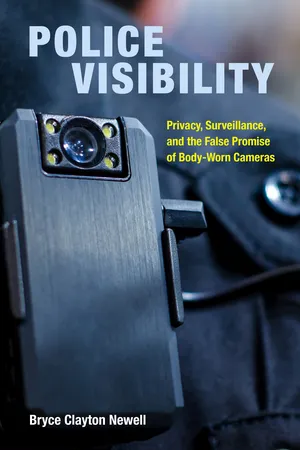
Police Visibility
Privacy, Surveillance, and the False Promise of Body-Worn Cameras
- 260 pages
- English
- ePUB (mobile friendly)
- Available on iOS & Android
Police Visibility
Privacy, Surveillance, and the False Promise of Body-Worn Cameras
About this book
Police Visibility presents empirically grounded research into how police officers experience and manage the information politics of surveillance and visibility generated by the introduction of body cameras into their daily routines and the increasingly common experience of being recorded by civilian bystanders. Newell elucidates how these activities intersect with privacy, free speech, and access to information law and argues that rather than being emancipatory systems of police oversight, body-worn cameras are an evolution in police image work and state surveillance expansion. Throughout the book, he catalogs how surveillance generates information, the control of which creates and facilitates power and potentially fuels state domination. The antidote, he argues, is robust information law and policy that puts the power to monitor and regulate the police squarely in the hands of citizens.
Frequently asked questions
- Essential is ideal for learners and professionals who enjoy exploring a wide range of subjects. Access the Essential Library with 800,000+ trusted titles and best-sellers across business, personal growth, and the humanities. Includes unlimited reading time and Standard Read Aloud voice.
- Complete: Perfect for advanced learners and researchers needing full, unrestricted access. Unlock 1.4M+ books across hundreds of subjects, including academic and specialized titles. The Complete Plan also includes advanced features like Premium Read Aloud and Research Assistant.
Please note we cannot support devices running on iOS 13 and Android 7 or earlier. Learn more about using the app.
Information
Table of contents
- Title Page
- Copyright
- Contents
- Acknowledgments
- Note about Prior Publications
- Introduction
- 1 Visibility, Surveillance, and the Police
- 2 Privacy, Speech, and Access to Information
- 3 Bystander Video and “the Right to Record”
- 4 Policing as (Monitored) Performance
- 5 The (Techno-)Regulation of Police Work
- 6 Public Disclosure as “Direct to YouTube” Alternative
- Conclusion
- Methodological Note
- Appendix A. Tables
- Appendix B. Figures
- Notes
- Bibliography
- Index